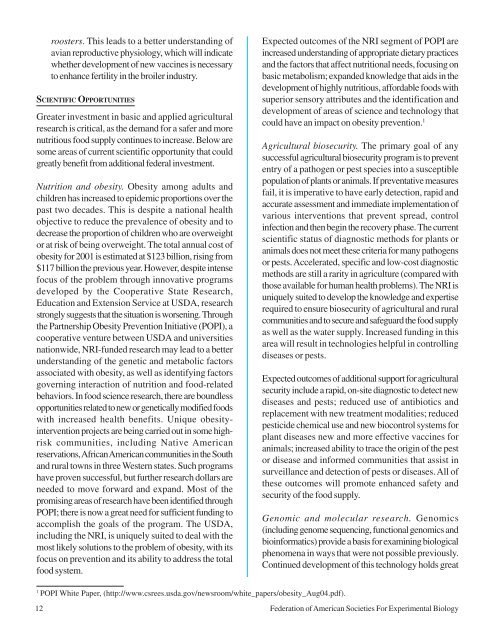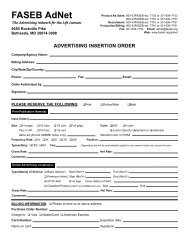national institutes of health - FASEB
national institutes of health - FASEB
national institutes of health - FASEB
Create successful ePaper yourself
Turn your PDF publications into a flip-book with our unique Google optimized e-Paper software.
oosters. This leads to a better understanding <strong>of</strong><br />
avian reproductive physiology, which will indicate<br />
whether development <strong>of</strong> new vaccines is necessary<br />
to enhance fertility in the broiler industry.<br />
SCIENTIFIC OPPORTUNITIES<br />
Greater investment in basic and applied agricultural<br />
research is critical, as the demand for a safer and more<br />
nutritious food supply continues to increase. Below are<br />
some areas <strong>of</strong> current scientific opportunity that could<br />
greatly benefit from additional federal investment.<br />
Nutrition and obesity. Obesity among adults and<br />
children has increased to epidemic proportions over the<br />
past two decades. This is despite a <strong>national</strong> <strong>health</strong><br />
objective to reduce the prevalence <strong>of</strong> obesity and to<br />
decrease the proportion <strong>of</strong> children who are overweight<br />
or at risk <strong>of</strong> being overweight. The total annual cost <strong>of</strong><br />
obesity for 2001 is estimated at $123 billion, rising from<br />
$117 billion the previous year. However, despite intense<br />
focus <strong>of</strong> the problem through innovative programs<br />
developed by the Cooperative State Research,<br />
Education and Extension Service at USDA, research<br />
strongly suggests that the situation is worsening. Through<br />
the Partnership Obesity Prevention Initiative (POPI), a<br />
cooperative venture between USDA and universities<br />
nationwide, NRI-funded research may lead to a better<br />
understanding <strong>of</strong> the genetic and metabolic factors<br />
associated with obesity, as well as identifying factors<br />
governing interaction <strong>of</strong> nutrition and food-related<br />
behaviors. In food science research, there are boundless<br />
opportunities related to new or genetically modified foods<br />
with increased <strong>health</strong> benefits. Unique obesityintervention<br />
projects are being carried out in some highrisk<br />
communities, including Native American<br />
reservations, African American communities in the South<br />
and rural towns in three Western states. Such programs<br />
have proven successful, but further research dollars are<br />
needed to move forward and expand. Most <strong>of</strong> the<br />
promising areas <strong>of</strong> research have been identified through<br />
POPI; there is now a great need for sufficient funding to<br />
accomplish the goals <strong>of</strong> the program. The USDA,<br />
including the NRI, is uniquely suited to deal with the<br />
most likely solutions to the problem <strong>of</strong> obesity, with its<br />
focus on prevention and its ability to address the total<br />
food system.<br />
Expected outcomes <strong>of</strong> the NRI segment <strong>of</strong> POPI are<br />
increased understanding <strong>of</strong> appropriate dietary practices<br />
and the factors that affect nutritional needs, focusing on<br />
basic metabolism; expanded knowledge that aids in the<br />
development <strong>of</strong> highly nutritious, affordable foods with<br />
superior sensory attributes and the identification and<br />
development <strong>of</strong> areas <strong>of</strong> science and technology that<br />
could have an impact on obesity prevention. 1<br />
Agricultural biosecurity. The primary goal <strong>of</strong> any<br />
successful agricultural biosecurity program is to prevent<br />
entry <strong>of</strong> a pathogen or pest species into a susceptible<br />
population <strong>of</strong> plants or animals. If preventative measures<br />
fail, it is imperative to have early detection, rapid and<br />
accurate assessment and immediate implementation <strong>of</strong><br />
various interventions that prevent spread, control<br />
infection and then begin the recovery phase. The current<br />
scientific status <strong>of</strong> diagnostic methods for plants or<br />
animals does not meet these criteria for many pathogens<br />
or pests. Accelerated, specific and low-cost diagnostic<br />
methods are still a rarity in agriculture (compared with<br />
those available for human <strong>health</strong> problems). The NRI is<br />
uniquely suited to develop the knowledge and expertise<br />
required to ensure biosecurity <strong>of</strong> agricultural and rural<br />
communities and to secure and safeguard the food supply<br />
as well as the water supply. Increased funding in this<br />
area will result in technologies helpful in controlling<br />
diseases or pests.<br />
Expected outcomes <strong>of</strong> additional support for agricultural<br />
security include a rapid, on-site diagnostic to detect new<br />
diseases and pests; reduced use <strong>of</strong> antibiotics and<br />
replacement with new treatment modalities; reduced<br />
pesticide chemical use and new biocontrol systems for<br />
plant diseases new and more effective vaccines for<br />
animals; increased ability to trace the origin <strong>of</strong> the pest<br />
or disease and informed communities that assist in<br />
surveillance and detection <strong>of</strong> pests or diseases. All <strong>of</strong><br />
these outcomes will promote enhanced safety and<br />
security <strong>of</strong> the food supply.<br />
Genomic and molecular research. Genomics<br />
(including genome sequencing, functional genomics and<br />
bioinformatics) provide a basis for examining biological<br />
phenomena in ways that were not possible previously.<br />
Continued development <strong>of</strong> this technology holds great<br />
1<br />
POPI White Paper, (http://www.csrees.usda.gov/newsroom/white_papers/obesity_Aug04.pdf).<br />
12 Federation <strong>of</strong> American Societies For Experimental Biology





